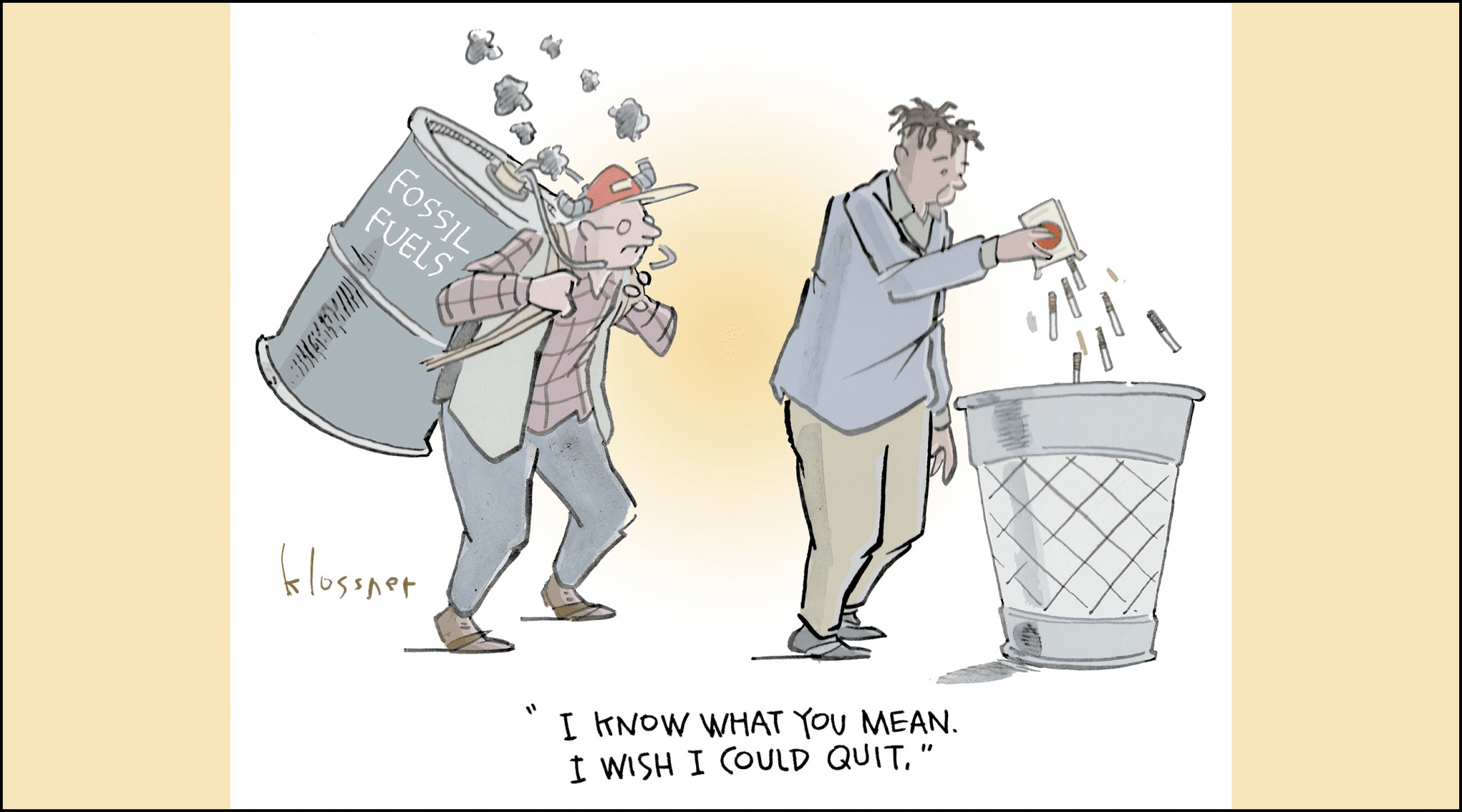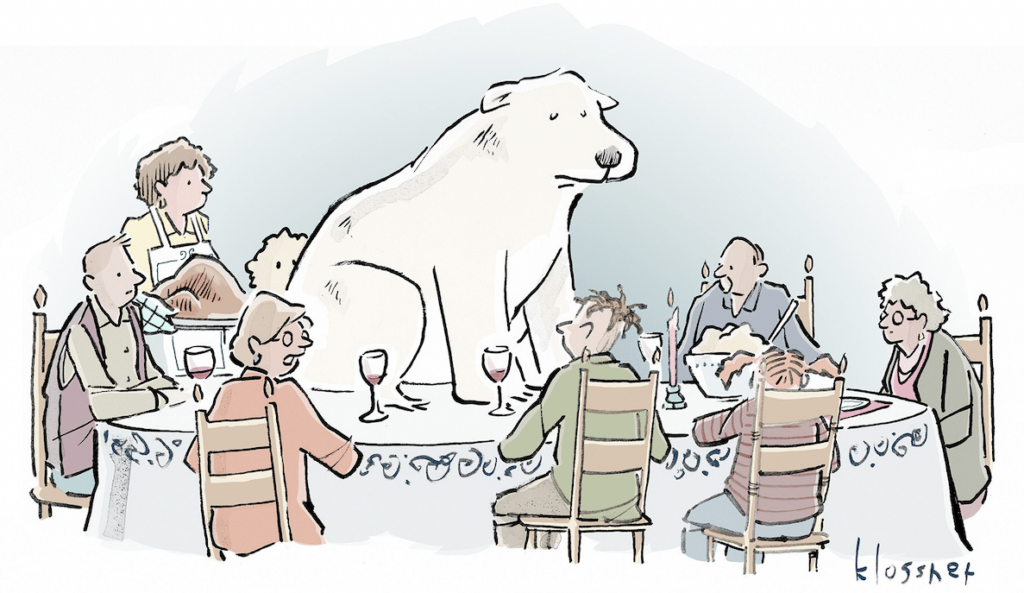By now, most of us are pretty aware that 1) there’s a climate crisis and that we need to do something about it ASAP, and 2) that we’ve got a whole bunch of solutions—they just need to be deployed much, much faster. The quickest way to avert a worsening climate crisis is, as writer-activist Bill McKibben succinctly put it, to “stop burning things.” Specifically, we need to stop burning the fossil energy sources that are warming our planet—mainly coal, oil, and natural gas—and to adopt cleaner energy sources like wind and solar.
Cutting fossil fuels out of our lives won’t be easy, since they are embedded in most aspects of our lives (from how we heat and cool our homes, to how we get around, to how our food is grown and transported, to petroleum-based products in our closets, wardrobes, and kitchens) and since the fossil fuel industry has embedded itself into much of our political systems. But we’re no longer completely tethered to fossil fuels; we have choices now, and cutting out major chunks of our fossil fuel consumption can be likened to kicking any other bad habit, like quitting smoking or breaking a sugar addiction. It isn’t as straightforward, and it might take a little longer, but why not try the same plan of attack? Rather than sitting on the sidelines reading dire headlines, why not get in the game?
In the spirit of the new year, we offer some bonafide steps for quitting fossil fuels, modeled on the CDC’s guidance for quitting smoking. With a solid game plan in place, you can start “getting clean” while also saving money and supporting justice and equity ideals. What are you waiting for?
Disclaimer: When quitting fossil fuels, you may experience moments of depression, withdrawal, guilt, or fatigue. This is NORMAL. Remember, you’re trying to make changes to your lifestyle that are not always easy, and you should feel proud of your commitment. Also, be aware that your daily habits and actions aren’t shaped solely by your individual choices, but by the physical, social, and political environment in which you live. “The system” may push back hard, making it tempting for you to cling to your high-carbon habits. Stay the course, knowing that you’re doing the right thing.
Before You Quit
Know Your Reasons for Quitting:
So you want to quit fossil fuels? It’s important to understand why you’re making this change. Do you want to live healthier? Save money? Have more convenience? Support greater energy independence? Leave a better world for your kids? Be on the right side of history? These are all great reasons. Also, think about what you dislike about your current dependence on fossil fuels. Is it the choking exhaust from your morning commute? Worsening floods or wildfires in your region? Whatever the reasons, write them down so you can remind yourself of them every day. Knowing what you’ll gain by reducing your reliance on dirty energy can inspire you to find cleaner alternatives to meet your everyday needs.
Make a Decision to Quit:
Sometimes, you just gotta say, “enough is enough” when it comes to burning things. But make sure you put it in writing, and (ideally) share it widely. Across the U.S. and worldwide, more and more people are taking the jump and opting for low-carbon lifestyles. They’re joined by thousands of cities, states, companies, and communities that have pledged to quit fossil fuels by going net zero or fossil free. You can set your commitment to clean energy by taking Gen180’s “Going Electric” Pledge (including making your next car an EV) or even divesting from fossil fuels. By making lifestyle shifts that are good for you, your family, and your community, you’re saying yes to a better collective future for everyone.
Identify Steps to Quit:
Identify the steps that will work for you to quit fossil fuels. Consider actions that have the maximum impact while not costing an arm and a leg, including in areas like home energy use, transportation, and food. Maybe an EV makes sense for you, or a solar array on your roof. Can you start “electrifying everything” in your home? (maybe start with your weed eater or lawnmower and work your way up to swapping your gas furnace for an electric heat pump.) Most of these shifts will improve your well-being while saving you money in the long term. (Need more ideas? See this beautifully illustrated list.)
Build Your Quit Plan:
Now that you’ve identified the steps, start making an implementation plan. This plan will be unique to your lifestyle and needs, but should include some key elements. For one, set a “quit date” for when you want to start taking action. Give yourself time to build the knowledge, skills, and confidence you’ll need to stay committed, but don’t wait so long that you lose motivation. Then, let your friends and family know you’re “quitting fossil fuels,” and be specific about how they can support you. Identify potential obstacles or challenges that may come up, as well as strategies to overcome them, to improve your chances of sticking it through (more on this later). Establish some weekly or monthly goals and set rewards so you can celebrate your “quit milestones” (Met your energy savings goal? How about a tasty locally grown dinner…). Quitting fossil fuels is a process, so enjoy your achievements as they come.
Implementing Your Plan: Strategies for Effective Quitting
Manage Your Quit Day:
It’s the big day! You’re ready to take dedicated action to better your life (and everyone else’s). Revisit your list of reasons for quitting fossil fuels and shifting to clean energy. Review your quit plan. To avoid distractions, keep the day’s schedule light so you can really focus on the tasks ahead, and how you’re going to implement them. If you’re aiming to cut back on gasoline use, plan out your day to combine trips, or make your car keys less accessible. Be honest about how much you can take on initially (you don’t want to burn out on all your ambition). Ultimately, your “quit day” may be underwhelming, but that’s ok—it just matters that you do something, however small, to move toward your fossil-free goal.
Recognize Signs of Depression:
Being a clean energy champion can be exciting—and tiring. You’ll face struggle, withdrawal, frustration. You might feel like you’re not doing enough, fast enough, or you might feel guilty about “relapsing” when you fly to visit friends or family (it’s okay, give yourself a break!). Climate grief is real. Mood changes and self-doubt are common when you’re making big (or small) lifestyle shifts. You might feel a sense of loss of your “old” (high-carbon) life. Embrace these emotions and work through them. Remind yourself that you’re shifting to something better—both for yourself and for the planet.
Reduce Your Stress:
Quitting fossil fuels is not at all about depriving yourself of pleasure. Some things will just work differently. Get excited by the challenge, and be creative. That twenty-minute fast-charging stop for your EV means you can get some exercise, enjoy a meal, or try some meditation. Take a deep breath. Remind yourself (again) why you’re quitting fossil fuels. Celebrate your “quit milestones” with things that bring you joy. Envision that appealing, fossil-free world!
The Long Haul: Maintaining Your Quit
Prevent Slips:
Inevitably, the parts of our system still under the fossil fuel regime will trip you up. This is all normal. Try to anticipate potential “triggers”—the people, places, things, and situations that draw you back into the old paradigm—and find creative ways to deal with them. Create incentives and strategies to keep up your clean energy, low-carbon lifestyle, and make it convenient. Keep your bike by your front door, with your lock, helmet, and saddlebags ready to go.
Build Support to “Stay Quit”:
It’s easier to stick with something if you’re held accountable. This means tapping into your peer network for reinforcement, and sharing your intentions far and wide to create expectations for success. Surround yourself with folks who understand and support your commitment to getting off fossil fuels, or who are taking similar steps themselves. Try to get family and friends on board (this may involve difficult conversations with that uncle of yours), but explain why this shift is important to you, and get personal about it (check out David Suzuki Foundation’s CliMate tool for tips on conversation techniques). Lend your support to others who have similar goals.
Prepare to Stay “Fossil Fuel-Free”:
You’ve got this, now keep it up! Now that you’ve made important changes in your own life, it’s crucial to share your experience with others. This can maximize the your “ripple effect”, working to shift the social norms around you. Remember that you have more influence on those around you than you might realize. Ultimately, these individual actions need to be scaled up and combined with mutually reinforcing changes at the government and corporate levels. Raise your voice within your community and advocate for wider structural changes that enable clean energy adoption. Support efforts by the federal, state, and local governments to enhance EV infrastructure. Encourage subsidies for public transport and greater energy efficiency for buildings. Vote for clean energy.
Enjoy the Benefits of Quitting:
Above all, celebrate what you’re gaining! Hold strong to your vision of contributing to a better world, and embrace your role as a changemaker. Enjoy your rewards, and congratulate yourself. There’s no time like the present to create a better future.















